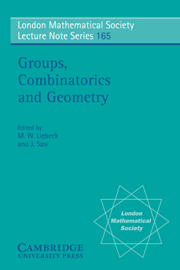Book contents
- Frontmatter
- Contents
- Authors' Addresses
- Introduction
- Part 1 Sporadic groups
- Part 2 Moonshine
- Part 3 Local and geometric methods in group theory
- 11 The classification of 3-transposition groups with trivial center
- 12 (S3,S6,)-Amalgams
- 13 Pushing down minimal parabolic systems
- 14 Nonspherical spheres
- 15 On the 2-local structure of finite groups
- 16 Groups generated by k-root subgroups – a survey
- Part 4 Geometries and related groups
- Part 5 Finite and algebraic groups of Lie type
- Part 6 Finite permutation groups
- Part 7 Further aspects of simple groups
- Part 8 Related topics
11 - The classification of 3-transposition groups with trivial center
Published online by Cambridge University Press: 07 September 2010
- Frontmatter
- Contents
- Authors' Addresses
- Introduction
- Part 1 Sporadic groups
- Part 2 Moonshine
- Part 3 Local and geometric methods in group theory
- 11 The classification of 3-transposition groups with trivial center
- 12 (S3,S6,)-Amalgams
- 13 Pushing down minimal parabolic systems
- 14 Nonspherical spheres
- 15 On the 2-local structure of finite groups
- 16 Groups generated by k-root subgroups – a survey
- Part 4 Geometries and related groups
- Part 5 Finite and algebraic groups of Lie type
- Part 6 Finite permutation groups
- Part 7 Further aspects of simple groups
- Part 8 Related topics
Summary
INTRODUCTION
A conjugacy class D of 3-transpositions in the group G is a class of elements of order 2 such that, for all d and e in D, the order of the product de is 1, 2, or 3. If G is generated by the conjugacy class D of 3-transpositions, we say that (G, D) is a 3-transposition group or (loosely) that G is a 3-transposition group. Such groups were introduced and studied by Bernd Fischer who classified all finite 3-transposition groups with no nontrivial normal, solvable subgroups. His work was of great importance in the classification of finite simple groups.
The basic example of a class of 3-transpositions is the class of transpositions in any symmetric group. This was the only class which Fischer originally considered, but Roger Carter pointed out that examples could be found in several of the classical groups as well. The transvections of symplectic groups over GF(2) form a class of 3-transpositions, so additionally any subgroup of the symplectic group generated by a class of transvections is also a 3-transposition group. The symmetric groups arise in this way as do the orthogonal groups over GF(2). Symplectic transvections over GF(2) are special cases of unitary transvections over GF(4), and this unitary class is still a class of 3-transpositions. The final classical examples are given by the reflection classes of orthogonal groups over GF(3).
Information
- Type
- Chapter
- Information
- Groups, Combinatorics and Geometry , pp. 121 - 138Publisher: Cambridge University PressPrint publication year: 1992
Accessibility standard: Unknown
Why this information is here
This section outlines the accessibility features of this content - including support for screen readers, full keyboard navigation and high-contrast display options. This may not be relevant for you.Accessibility Information
- 3
- Cited by
